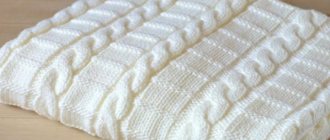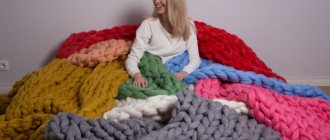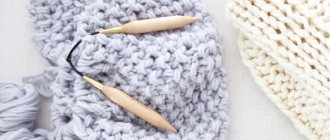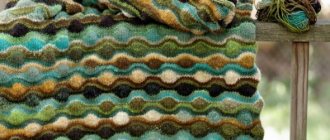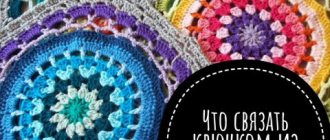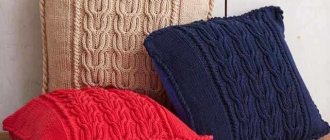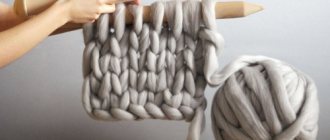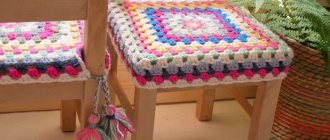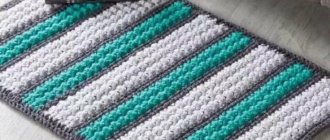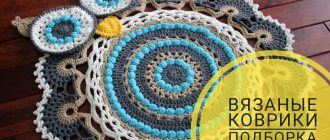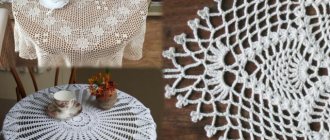- 47629
- 13-10-2020
- Author: Mysekret Team
- 0
Knitted blankets are one of the most cozy and pleasant things that you can create with your own hands. In addition, such a household item, which will warm you up on autumn or winter evenings, can also be incredibly beautiful. Perhaps novice craftswomen will now think that such a luxury as a knitted blanket is not for them, but you should not deprive yourself and your loved ones of such a wonderful thing because of doubts in your abilities. You just need to choose the appropriate one from several options for knitting simple blankets and go for it!
Tool selection
All knitting needles vary in size and shape:
- Single straight models.
- Circular knitting needles, with fishing line.
Depending on the shape of the chosen blanket model, you should focus on the choice of knitting needles. The diameter of the knitting needle is also an indicator that depends on the thickness of the thread, the knitting method and the specifics of the pattern.
Patchwork style blankets
It is better, of course, to knit large size blankets from individual squares in patchwork style. Yes, you can use a wide variety of colors and patterns: just garter stitch, and patterns with braids, and in general the most unimaginable patterns in one blanket, you can even combine knitting with crochet.
Tip: when sewing squares, place them in a checkerboard pattern in the direction of knitting - sometimes along, sometimes across, this way the product will be more even and will not stretch to one side.
You can embroider tracks over the seam in a contrasting color.
On our blog there is a diagram and a detailed description of knitting the famous, beautiful “Winter” blanket from squares with leaves.
Selection of materials
Today, beginners and experienced needlewomen are offered the following types of yarn:
- Wool.
- Acrylic.
- Mohair.
- Angorka.
- Linen threads.
- Alpaca.
Each of the presented models is used to create blankets of different structure, differing in the degree of softness, resistance to washing and stretching, and decorative properties.
Care
To ensure that the blanket retains its original appearance, follow these tips.
- Do not store knitted items in tight piles, otherwise the yarn will fray.
- Before putting the blanket in the closet, do not forget to wash it. Sweat and dirt attract moths.
- Put moth repellent in your closet.
- Always wash knitted items by hand. The washing machine harms the products (stretches, confuses the wool).
- Wash with warm, but not hot water.
- Do not dry blankets in front of radiators. It is better to lay it out on a flat surface and leave it there until it dries completely.
Wool for a blanket
Natural fiber with a pleasant appearance. It features the greatest possible variety of shades, which allows you to work on creating an original design.
The thread is strong, but the finished product is not durable. After several washes, the blanket may stretch, shrink, or lose its original appearance.
In addition, it will be extremely difficult for novice needlewomen to work with this type of yarn. Baby blankets should not be knitted from pure wool yarn, as the material will scratch the baby’s delicate skin.
We recommend reading:
- Knitting bactus with knitting needles - detailed description with photos and diagrams. Step-by-step instructions and recommendations from craftswomen. TOP 30 best models
- Knitting socks with knitting needles - step-by-step master class with instructions. A selection of the best knitted socks models
Garter Stitch Knitting - 140 photos and videos of basic garter stitch patterns and projects
Best tool
Typically, needlewomen use one of two tools for knitting.
- Knitting needles.
- Hook.
Of course, there is needle knitting. However, this technique has not become widespread due to the great complexity of execution.
Hook
Crochet hooks come in different sizes and shapes.
Crocheting with this wonderful tool is very easy, so it is perfect for beginners. They create a variety of patterns. It is small, compact and does not take up much space.
The main disadvantage is the ribbing and rigidity of the products. The row of loops is not tight, creating a simple thing takes a lot of time.
Spokes
Knitting needles of different thicknesses and lengths
Suitable for more experienced craftswomen. Knitting with them is difficult, but when compared with crocheting, the process of creating airy patterns becomes noticeably more complicated. They allow you to knit large projects in a short time (an experienced knitter can make up to four loops per second). Things turn out soft, smooth (all loops, regardless of tension, will be equal to each other), pleasant to the skin.
There are several types of knitting needles.
- Open
Open or stocking knitting needles
Sold in sets of five. Relatively short, pointed on both sides. The main purpose is knitting in the round. Suitable for making mittens and socks.
- Closed.
Straight closed knitting needles
Sold as a pair. The longest of all knitting needles. They are convenient for knitting long, straight items, such as a scarf or sweater. Often used to create a blanket.
- Circular
Circular or circular knitting needles
They are two short sticks connected with a thin fishing line. They are universal and can replace any knitting tool. Disadvantages include:
- the need to accurately select the length of the fishing line;
- complex knitting technique.
When you decide to knit a blanket with knitting needles, use closed knitting needles. They will prevent the loops from slipping from the reverse side and allow you to create a variety of motifs. In addition, they make it easier to change yarn colors.
Acrylic for knitting
A synthetic fiber characterized by a pleasant shine of the finished product. The thread is strong, glides easily along the knitting needles, even a novice craftsman can work with it. Finished products are resistant to deformation and frequent washing.
However, acrylic threads are quite cold, so only summer knitted blankets are created using them.
And here https://gidrukodeliya.ru you can visit a real club for lovers of needlework and crafts.
Harness
A simple crochet tie will add a finished look to the finished blanket.
An interesting way to tie the edges of a product - shells
Having finished the blanket with knitting needles, it is advisable to crochet it. This is necessary to increase service life.
To do this you will need a short hook (3 mm) and yarn that matches the fabric.
1st row: tie the perimeter of the product st. b. n.;
2nd row: alternate 2 air. p., 3 tbsp. b. n.;
3rd row: knit 5 tbsp into the ring formed by air loops. n., then fasten 1 tbsp. n. (continue to the end of the row).
Beautiful edge trim with small pompoms
A simple but effective way to finish the edge - with beads
Mohair threads
This model is a combined version of yarn - natural fiber with synthetic additives. Using mohair allows you to create surprisingly warm blankets with long pile.
You should not start working with such threads, but with enough experience you can safely start knitting an original blanket. Finished blankets require special care and cleaning conditions.
Connecting squares
In order to make a blanket from squares, we need to knit the blanks (squares) and connect them together.
In the picture presented you see pieces of our future blanket (20 loops * 30 rows). You can use a needle and thread to connect them. You need to sew evenly, using the edge loops.
But this is not the only connection option. You can also use a crochet hook. To do this, you need to connect the squares by the edge loops with single crochets. This option is illustrated in the photo below.
Angora for blanket
Natural soft and fluffy fiber allows you to create children's blankets with bright patterns and delicate pile.
We recommend reading:
- How to knit a turban with knitting needles - 115 photos and videos of ideas, patterns and features of knitting a turban
Knitting bags - 155 photos and videos on how to quickly knit a stylish bag with descriptions and diagrams
Knitting a jacket: 125 photos and video description of knitting with patterns for beginners and masters
Unfortunately, some of the fluff will be lost during use, and after washing the fluff must be tidied up to return to its original appearance.
Patterned bedspread
Dimensions: 117cm by 137cm.
We will need:
- yarn, consisting of 82% acrylic, 10% wool, 8% viscose (170g per 97m) -1360g;
- circular knitting needles No. 8, line length 75 cm.
Patterns and techniques:
- double broaching: remove 1 p. front, 2p. in 1 sheet, throw the removed stitch onto the knitted one;
- decrease with a tilt to the left (UNL): remove 2p. on the right needle without knitting. Using the left knitting needle, we pass 2 removed loops from left to right, knitting them in 1 stitch. for the upper lobes;
- pearl pattern: 1p.: 1p.; 1i.; 2p.: above the faces. knit purl, over purl. – facial stitches;
- openwork pattern: 1p.: 1l.*1n., UNL, 7l., 2p. in 1l., 1n., 1l.* – from * to * repeat on all sts; 2 rub. and all purl:i.; 3p.: 1l., *1n., UNL, 5l., 2p. in 1l., 1n., 1l.* – from * to * repeat on all sts; 5p.: 1l., *(1n., UNL)x2, 3l., (2p. in 1l.)x2, 1l.* – from * to * repeat on all sts; 7p.: 1l., *1l., (1n., UNL)x2, 1l., (2p. in 1l., 1n.)x2, 2l.* – from * to * repeat on all sts; 9r. 1., *(1n., UNL)x2p., 1n., double broach, 1n., (2p. in 1p., 1p.)x2, 1p.* – from * to * repeat on all p.; 11r.: 1l., *3l., 2p. in 1l., 1n., 1l., 1n., UNL, 4l.* – from * to * repeat on all sts; 13r.: 1l., *2l., 2p. in 1l., 1n., 3l., 1n., UNL, 3l.* - from * to * repeat on all sts; 15r.: 1l., *1l., (2p. in 1l., 1n.)x2, 1l., (1n., UNL)x2, 2l.* – from * to * repeat on all sts; 17r.: 1l., *(2p. in 1l., 1n.)x2, 3l., (1n., UNL)x2, 1l. – from * to * repeat on all points; 19r.: 2p. in 1l., 1n., *(2p. in 1l., 1n.)x2, 1l., (1n., UNL)x2, 1n., double broach, 1n.* – repeat from * to *, (2p . in 1l., 1n.)x2, 1l., (1n., UNL)x3; 20 rub.: i. The vertical repeat of the pattern is from 1r. 20 rub.
Density: 8p. for 13r. equal to 10 cm by 10 cm.
Description
We dial 95p. and knit 6p. pearl rice Next, we knit 5 stitches along the edges of the fabric. pearl pattern, and the central part is made with an openwork pattern. We repeat the openwork rapport 8 times. We finish the work with 6 rows of pearl knot. Closed P.
Alpaca
This model is also a natural fiber that has a number of pleasant properties:
- The material does not cause allergies, which is important when knitting children's blankets.
- The finished product is resistant to deformation and pilling during washing.
- The blanket will be particularly durable, but at the same time, have a soft pile.
Working with yarn is very easy and quick.
Blanket knitted from squares: what knitting techniques are used
The easiest and cheapest way, even for inexperienced knitters, to make a blanket from squares on knitting needles is to knit individual motifs and then join them into one fabric in a straight line. The patchwork style technique is often used, when square-shaped spots can be interspersed with motifs of other geometric shapes.
When knitting a blanket with square knitting needles, there is a great opportunity to get an original warm product by using up the remainder of the yarn from the knitter’s previous work. It is only important to remember that it is quite acceptable to use threads of different qualities and from different materials, but the main condition is to use yarn of the same thickness.
There is a technique for knitting a blanket when squares are connected into larger elements, even square (or rectangular) in shape, after which the enlarged parts are separated by strips of knitted fabric, as if making up a frame. This is also an interesting option for making a blanket.
For children, blankets are often knitted from squares with embroidery or appliques in the center. A bright baby blanket is not only beautiful, but also helps the baby develop. Children learn to concentrate and recognize colors, as well as animal figures or various objects depicted on the applique.
Knitting squares for a blanket
Identical individual square motifs can be knitted using different techniques:
- simple knitwear - hosiery, shawl, elastic, etc.;
- patterns containing braids, vertical lines, diagonal seams, etc.;
- knit “from the corner” when forming a braid along the diagonal of the square;
- in 3D style;
- using the "pixel" method, etc.
Master classes on knitting a blanket
Master classes on knitting blankets are necessary for both beginners in needlework and experienced craftsmen. After all, thanks to detailed instructions and pattern formation patterns, you can decide on the knitting technique and learn the best knitting methods for beginners.
Today, there are a huge number of classic work schemes and original author’s techniques.
We recommend reading:
- Knitting a cardigan: 110 photos and videos on how to quickly and easily knit a stylish and beautiful cardigan
- Patterns for crocheting a tablecloth - 140 photos, descriptions of models and features of crocheting a tablecloth
- Crochet shawl patterns - step-by-step description of how to knit a shawl with your own hands
A selection of plaids and square motifs knitted with knitting needles
Warm blanket made from remnants of thread and square motifs with embroidery
Once upon a time, when my daughter was still very little, my only hobby was knitting. Then my husband gave me a knitting machine, and I sat in the carriage for several days. I knitted everything for the little girl, she always came with me in the most fashionable and elegant. And not only the child, the father-in-law also wore a fashionable pullover (he was still unhappy with his daughter-in-law).
What I mean is that over several years of this knitting practice, I collected a huge amount of remaining threads - three huge boxes with balls of different threads. There is nowhere to use them, but they are all recruited. When I saw this blanket, I felt great joy - after all, this is a great way to cleanse the house of what has been bothering us for years.
You will need to knit several squares with crochet or knitting needles and embroider them according to the following patterns, or you can knit them in any way you like) Then collect all the squares, knit them together and tie a blanket around the edge.
Knitting a baby blanket
To knit a warm blanket for children, it is necessary to comply not only with the color composition, but also with a number of requirements for the fiber:
- The yarn should not cause allergies or prick the baby's skin.
- The fabric should be breathable so as not to overheat the baby and allow the skin to breathe.
Natural types of yarn with a small addition of synthetic fibers have excellent characteristics (this will allow the product not to stretch after the first wash).
Detailed description of how to knit a blanket with your own hands:
- Select a drawing and download its diagram.
- If you have little experience in knitting patterns, it is worth doing a test knitting of the pattern.
- The work is best done with large knitting needles or knitting individual modules, which are then combined into a single product.
- Knitting a module: first of all, you need to cast on the required number of loops on both knitting needles.
- Release one knitting needle and then work with an English elastic band for 5-8 cm. Unlike classic elastic, this model is softer in texture.
- The pattern is knitted strictly according to the pattern.
- The end of the module is also represented by an English elastic band.
Photos of a children's knitted blanket in various modifications can be found in any magazine on practical needlework.
Material and tools
Independently and correctly knitting a blanket with knitting needles requires the preparation of high-quality material and tools. Not every type of thread is suitable for covering. For example, do not use yarn with the addition of metallized thread.
The material is beautiful, but it irritates the skin and will not be comfortable to cover. The main types of threads used: acrylic, wool, wool blend, cotton, angora with acrylic, mohair, wool with the addition of acrylic, grass.
Interesting! Cotton is very light and pleasant to the touch, so it is often used for knitting. Cotton also does not require special care.
The softest fabrics are those made from “grass” threads. Products made of wool or wool mixture are often used in winter due to their good heat retention. It is not recommended to make large projects from old yarn, because its surface is frayed and the fabric will turn out sloppy.
The selection of knitting needles is also important. They can be made of wood, metal, plastic, even bone. To find good tools, look at the polish (should be of a good level) and the sharpness of the ends - the ends should not be too sharp so as not to get hurt. But dull ones won’t work either, you need to look for the middle.
For light yarn, use knitting needles made of plastic or bone. For heavy ones, wooden and metal ones are suitable. The tool number corresponds to its diameter. To select the optimal diameter, you need to multiply the thickness of the yarn by 2.
During work, other equipment may be useful:
| 1. Row counters | They record the numbers. |
| 2. Knitting pin | The loops stop for her. |
| 3. Small scissors | Needed for additional work, the tip must be sharp. |
Sometimes you also need a knitting thimble, colored tips, bobbins, an iron, a notepad, a pencil, an eraser and a ruler.
Modular blanket made of squares
The main feature of this model is the ability to create it from the remains of multi-colored yarn. The finished product takes on an original look that fits perfectly with the high-tech and Provence style of the room's interior.
To work, you need to prepare straight knitting needles, yarn and, if desired, a pattern. Step-by-step instruction:
- Measure the dimensions of the square module.
- Depending on the size of the module, cast on the required number of loops on the knitting needles.
- Release one knitting needle and knit a square according to the chessboard principle: alternating purl and knit stitches 2*2, different in each row.
After creating all the modules, they should be connected with a knitting needle into a single product. Using a hook, you can create an original border along the edges of the blanket.
Bedspread with beautiful weaves - description and diagrams
Size: 95cm by 210cm.
We will need:
- yarn containing 75% acrylic, 20% mohair, 5% alpaca (50g per 70m) – 1300g;
- knitting needles No. 6.5.
Patterns:
- persons smooth surface: in knits. in rows with knit stitches, purlwise. R. - purl;
- garter stitch - all sts in all r. facial;
- pattern “Rice”: 1p.: 1l.; 1i.; 2p.: above the faces. knit purl, over purl. – facial stitches;
- pattern “Fantasy elastic band” according to the diagram;
- “Braids - plaits” - see diagram;
- main pattern “Rhombuses” - see diagram.
Density: on the “Rice” pattern 12p. for 19 rub. equal to 10 cm by 10 cm.
Explanation of symbols:
- cross of 6 p. to the right: remove 3p. on aux. sp. at work, 3l., 3p. with aux. sp. facial;
- cross of 6 p. to the left: remove 3p. on aux. sp. before work, 3l., 3p. with aux. sp. facial;
- cross from 3p. to the right through 1p.: remove 1p. on aux. sp. at work, 3l., 1p. with aux. sp. purl;
- cross from 3p. to the left through 1p.: remove 3p. on aux. sp. before work, 1i., 3l. with auxiliary sp.;
- cross from 3p. to the right after 1 p.: remove 1 p. on aux. sp. at work, 3l., 1p. with aux. sp. persons.;
- cross from 3p. to the left after 1 p.: remove 3 p. on aux. sp. before work, 1l., 3l. with auxiliary sp.;
- cross from 1p. to the left after 2 p.: remove 1 p. on aux. sp. before work, 2l., 1l. with auxiliary sp.
How to knit a blanket - detailed description
We cast on with knitting needles 140 sts. and knit: 8p. – “Rice”, 5p. – fantasy cutting, 3p. – “Braids”, 5p. – fantasy cutting, 26p. – “Rhombuses”, 5p. - phantom cut, 3p. – “Braids”, 5p. – fantasy cutting, 20p. – “Rice”, 5p. - phantom cut, 3p. – “Braids”, 5p. – fantasy. cutting, 26p. – “Rhombuses”, 5p. - phantom cut, 3p. – “Braids”, 5p. - phantom cutting, 8p. - "Rice".
Having knitted the blanket 23 cm (= 44 r.), on the sections of the “Rice” pattern we begin to perform * 2 r. persons satin stitch, then - 6p. shawl rice, 2p. persons ch., then return to the knot. “Rice” and knit 50 rubles* - from * to * repeat with knitting needles to the desired height until the part is full size.
Having completed 398r. (=210cm) and knitting the 12th r. “Rombov”, we finish the work by closing all points.
Knitting Canadian elastic
The technique is based on the creation of an openwork motif and relief patterns on the canvas. Before starting work, it is worth creating a ready-made scheme for forming the ornament, deciding on the color composition and size of the blanket.
For beginning craftsmen, the modular principle of operation or the use of circular knitting needles, which allow knitting large items, is best suited.
Turquoise bedspread
Dimensions: 112cm by 148cm.
We will need:
- yarn containing 75% acrylic, 25% wool (100g per 190m) – 1300g;
- circular knitting needles No. 8, line length 80 cm.
Patterns:
- double pearl pattern: 1p. (front): 1l., *1i., 1l.* – from * to * repeat on all sts; 2p.: 1i., *1l., 1i.* – from * to * repeat on all sts; 3p.: like 1p.; 4r.: like 1r.
- relief pattern: according to the diagram.
Density: in stockinette stitch with yarn in two threads 11p. for 16r. equal to 10 cm by 10 cm.
Description
We will make a knitted blanket using two strands of yarn. We cast on with knitting needles 119 sts. and knit a double pearl rice for 16p., in the last one we add 12p. at regular intervals. It turns out 131p.
We continue to knit the blanket with knitting needles: 1p. (knits.): 1l., [1i., 1l.]x5.2i. * 25p. -1st r. according to cx. relief pattern, 2i., 1l., [1i., 1l.]x5, 2i.* - from * to * repeat again, 2i., 1l., [1i., 1l.]x5; 2p.: according to the drawing; 3p.: 1i., [1l., 1i.]x5, 2p., *25p. -3rd r. according to cx. relief knot., 2l., 1i., [1l., 1i.]x5, 2l.* from * to * repeat again, 2l., 1i., [1l., 1i.]x5; 4 rubles: according to the drawing.
We continue to work with knitting needles, repeating from 1 p. 4 rubles each double pearl knot, knit stitches of embossed pattern according to c.
Combed ribbon blanket
Very often, such soft and stylish blankets are knitted by hand without using tools, but using large knitting needles you can also successfully knit a blanket. Advantages for beginner needlewomen:
- Easy working technique.
- A huge selection of instructions, diagrams and educational video lessons.
- Stylish design and bright colors of wool yarn.
However, care should be taken when working with combed tape as the material can tear easily.
Crochet blanket made from square motifs, models from our website
Cozy blanket knitted with square motifs
Cozy blanket. Materials: poly yarn, about 1 kg, knitting needles with a diameter of 4 mm. Example: people are smooth 22r and 30r -10/10cm. For the first square, start 44 stitches and knit a row. Mark the center with a marker or a colored pin. IN
How to knit square patchwork motifs for a pillow or blanket
Goodbye! At the beginning of summer, I published a post in which I published my interior works using the patchwork technique, that is, a “Sand Castle” cushion cover. You can view this work here. There you can also watch a video tutorial, according to which
Children's blanket with dogs (imitation square motifs)
A cozy baby blanket with dogs will bring pleasure not only to children, but also to adults. Dimensions: 82x86 cm Materials needed: Cascade 128 Superwash yarn (100% wool; 117 m / 100 grams per skein) – 6 skeins of moss color (yarn
Knitted blanket with arans and square motifs
The blanket consists of 20 squares. The size of each square is 15.5 cm * 17.5 cm. The size of the blanket is 85 cm * 60 cm. You will need 4 colors of yarn and suitable knitting needles; hook for tying a blanket. Follow Pattern A for 5 Reasons
Knitted blanket made of square motifs for a newborn
Two square blankets for a newborn. Acrylic yarn for children. I don't remember the video. 50 g in a skein. Knitting needles 2.5 The size of the blanket turned out to be 88 * 88 cm. Each color took 3 skeins. The front is completely tied in satin stitch. Each square of the blanket is connected by 70 edges,
Knitted baby blanket (square motifs with cats)
Blanket for future granddaughter. Dimensions 75 × 72, weight 213 g. I specially knitted this size for discharge from the maternity hospital, if, of course, my daughter likes it. Children's medical yarn Himalaya (100g / 310m). Composition: 70% acrylic and 30% amicor. The yarn is antibacterial, hypoallergenic. Manufacturer's recommendation
Plaid with zig-zag pattern
This pattern for the ornament is one of the simplest. To create an original and beautiful blanket, you should use the instructions:
- Determine the expected width of the blanket.
- Cast on the required number of stitches on the knitting needles.
- Knit the first 5-6 cm with an English elastic band.
- The next two rows of fabric should be garter stitch.
- A zigzag pattern is made with threads of a different color.
- Pattern for the ornament: edge loop, 1 sheet. p., yarn over, 6 l. p., 3 loops knit together, 6 l. n. Repeat until the end of the row, finish 1 l. p., 1 edge loop.
- In the second row, all yarn overs are knitted with purl stitches.
The pattern of the ornament is repeated until the end of the entire blanket, and the last 5-6 cm are knitted with an English elastic band.
Blankets with cords
All kinds of patterns with braids look impressive on any product, and it seems to me that blankets like these are especially cozy.
I don’t provide any diagrams; you can choose any one to suit your taste on the Internet and in magazines.
In addition, on our blog we already have ideas for beautiful blankets with cords with patterns: a white blanket and a blanket in blue tones.
Photo of a blanket with knitting needles
Did you like the article?
3+
How to knit a blanket with a relief pattern of knit and purl stitches
To create a simple “Chess” pattern on a blanket (pattern repeat of 14 rows):
- Cast on the number of stitches corresponding to the required size.
- The first row implies: 6 knit stitches, 5 purl stitches behind the back wall, 5 knit stitches, 5 purl stitches, 5 knit stitches, 1 purl stitch.
- Switch to the reverse side of knitting.
- The second row should contain: 1 lt, subsequent ip loops throughout the entire row.
- The third, fifth, seventh rows must be worked in the same way as the 1st.
- In the fourth and sixth rows, repeat the sequence of stitches knitted in the 2nd row.
- 8th row: 6 lpt, 5 ipt behind the back wall, 5 lpt, 5 pt, 5 lpt, 1 pt.
- Turn the product over.
- Row 9 should consist entirely of lpt.
- Knit rows 10, 12, 14 based on the pattern of row 8.
- Rows 11, 13 repeat 9.
- Repeat this algorithm until the required size of the pattern on the blanket is obtained.
- Close the loops.
Crochet a blanket
Crocheting is much more difficult than knitting. If you choose this type, then you are either a professional in this matter or a “burning” connoisseur of this type of skill. You can make relatively many different works of art with crochet. But I want to warn you that it is also relatively long-lasting. And when choosing yarn, it is worth considering that the thickness of the final product will depend on its thickness.
Crochet a blanket with a square motif
In this case, a 9x9 cm motif with a simple and light pattern will be repeated on the blanket. Marcerized cotton should be selected for machine knitting with 3 strands. Hook No.1. The product weighs 2 kg. You can choose any color, but white will be too easily soiled (I don’t recommend buying it for those who have small children, because you’ll be bothered to wash it). But there is one more nuance possible.
The knitting time may take a little longer due to the large size of the blanket. Well, think for yourself, the size is 248*168 cm after all! But it is more convenient to knit with a motif due to a number of factors:
- no need to drag a ball of wool behind you;
- if the workpiece is damaged, then it can be unraveled and thrown away, but with a whole canvas this number will not work;
- you can knit a piece of linen anywhere and carry it anywhere;
- It is quite possible to knit each square according to different patterns, so it will turn out even more original!
The knitting density should be based on the following parameter: the first 3 circles of the motif are 5 cm in diameter. Motives need to be knitted according to the pattern. If you have already reached the 8th circle, then after that you need to connect 16 rows of 24 motifs. You can see everything on the diagram. And to make a border, you need to fasten the thread into an arch on a needle and tie the entire blanket according to the pattern. As a result, you will get an openwork, beautiful, practical and, of course, warm blanket.
Blankets and bedspreads find their application in the interior
Did you know that a blanket or bedspread can be used as a throw on a sofa or bed? It is now stylish and comfortable. Many women prefer to use handmade items for this purpose.
A fabric made from strands, stripes, intertwined braids, and purl loops looks very fashionable and beautiful. But the patterns haven’t gone far either. The most interesting are Tunisian knitting, Bavarian knitting, double-sided and Scandinavian. You can choose any selection.
Selection of yarn and working tools
The blanket can be knitted thick or light. This may be a small product intended for a child. They knit blankets for adult double beds. In each individual case, the choice of yarn and working tool is made.
- Most often, threads of medium thickness are preferred. It can be cotton if the product is intended to be used in the summer.
- Wool is used for warm clothes. Acrylic or its addition to any type of yarn is considered a universal solution.
- Recently, plush microfiber has gained increased popularity.
Having chosen the yarn, they decide on the tool for work. They take into account the recommendations of the thread manufacturer, as well as their own skills and preferences.
